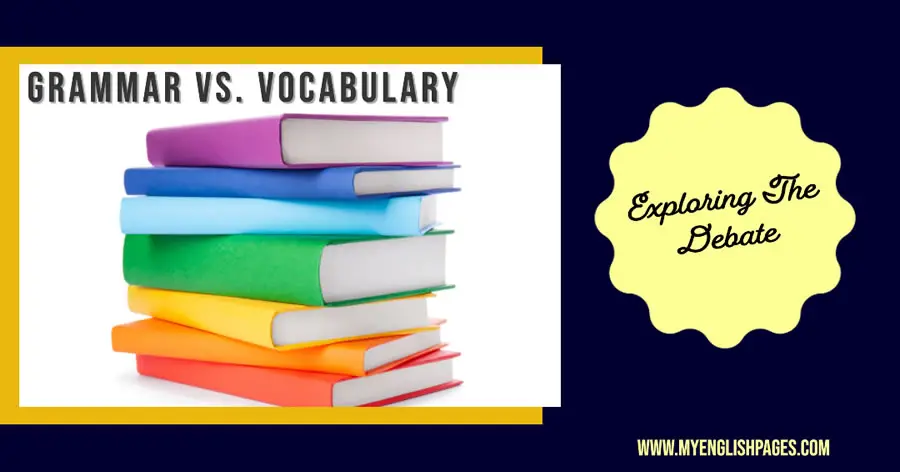Here is the short answer to the question: Which should come first in language learning: grammar or vocabulary?
Both grammar and vocabulary are essential in language teaching. While little can be conveyed with grammar alone, vocabulary allows for basic communication. Grammar, however, provides the necessary structure for effective and meaningful expression.
Table of Contents
Introduction
Language learners often question whether grammar or vocabulary should take precedence in their language-learning journey. Traditionally, grammar has been given primacy, with vocabulary serving as mere illustrations of grammatical structures. That’s why, in most traditional textbooks, grammar comes first and it is only later that reading and vocabulary are introduced.
However, a growing body of thought emphasizes the role of meaning and suggests a shift in pedagogical approaches.
This article explores the importance of vocabulary in language learning, its connection to grammar, and the implications for effective language instruction.
Grammar or Vocabulary First?
In language learning, a perennial question arises: should one prioritize grammar or vocabulary when acquiring a new language? The debate surrounding this topic has sparked various theories and teaching approaches. Traditionally, grammar and vocabulary have been treated as separate entities, with distinct instructional methods dedicated to each.
Recent approaches, however, have tried to strike a balance between the two components. Vocabulary is viewed as vital to communication while grammar is considered crucial for accurate language use.
Traditional Methods of Teaching
Traditionally, grammar is taught first; it has primacy over vocabulary. Vocabulary items were merely used as vehicles to explain grammatical structures. In other words, this type of teaching prioritizes form and utilizes lexical items solely as examples of the structures previously taught. That’s why, in most traditional textbooks, grammar is introduced before reading and vocabulary.
However, in recent times, meaning has gained paramount importance in language teaching (or, should I say, learning) processes. As H.G. Widdowson (1990: p. 95) points out:
“Teaching that prioritizes form and treats words as mere means of exemplification actually disregards the nature of grammar as a construct for mediating meaning. I would suggest that a more natural and effective approach would be to reverse this traditional pedagogic dependency, starting with lexical items and demonstrating how they need to be grammatically modified for effective communication.”
Widdowson (1990: p. 95)

Why Is Vocabulary Important?
Firstly, it is easier to communicate effectively and with fewer difficulties when one possesses a sufficient grasp of appropriate vocabulary within the given context. Relying solely on grammatical rules would undeniably hinder effective communication. The true essence of a structure lies primarily in the meaning conveyed by the lexical words with which it is constructed.
As David Wilkins argue:
“without grammar, little can be conveyed, without vocabulary, nothing can be conveyed.”
David Wilkins
What this means is that vocabulary has an important place in language learning.
According to Michael Lewis, fluency is not heavily reliant on a set of generative grammar rules, as proposed by Chomsky, or a separate stock of words, but rather on the ability to quickly access a repertoire of lexical chunks. In the lexical approach, lexis plays a central role in establishing meaning, while grammar assumes a secondary role in managing it. Consequently, teachers should allocate more time to helping learners develop their repertoire of phrases and less time to focusing on grammatical structures.
Secondly, a substantial inventory of vocabulary items is a prerequisite for proficient reading and, presumably, listening skills. It is evident that a lack of familiar vocabulary items poses one of the most significant obstacles during reading activities. While syntax may aid in constructing textual meaning, the foundation of any interpretation unquestionably rests on the lexicon. Attempting to read a text composed mostly of unfamiliar words will clearly demonstrate the significant contribution of the lexicon to meaning.
| Importance of Vocabulary |
|---|
| Effective Communication |
| – Eases communication with fewer difficulties |
| – Grasping appropriate vocabulary in context is crucial for effective communication |
| – Relying solely on grammatical rules hinders effective communication |
| – The meaning conveyed by lexical words forms the true essence of a structure |
| – Fluency depends on quick access to a repertoire of lexical chunks rather than grammar rules or a stock of words |
| – Lexis (vocabulary) plays a central role in establishing meaning, while grammar manages it |
| – Teachers should prioritize helping learners develop their repertoire of phrases over focusing only on grammatical structures |
| Reading and Listening Skills |
| – A substantial inventory of vocabulary items is necessary for proficient reading and listening skills |
| – Lack of familiar vocabulary items poses a significant obstacle during reading activities |
| – While syntax (grammar) aids in constructing textual meaning, the foundation of interpretation relies mainly on the lexicon (vocabulary) |
| – Reading a text with unfamiliar words highlights the significant contribution of the lexicon to meaning |
Examples of the Importance of Vocabulary
Vocabulary knowledge plays a critical role in facilitating effective language use. When it comes to communication, vocabulary holds significant weight, enabling us to convey basic ideas even without an in-depth understanding of grammar rules. Let’s delve into an example that illustrates the power of vocabulary in communication.
Imagine you find yourself in a bustling marketplace, searching for a specific ingredient to complete a recipe. As you navigate through the crowded stalls, you approach a vendor with a wide array of spices. Instead of constructing a full sentence or relying on complex grammar, you simply utter the word “salt.” Surprisingly, the vendor instantly comprehends your request and promptly provides you with the desired item. In this instance, the word “salt” acts as a standalone word, carrying a wealth of meaning and evoking a shared understanding between you and the vendor. It showcases the efficiency and effectiveness of vocabulary in facilitating quick and accurate communication.

Need more examples? Consider the following scenarios:
- Cross-Cultural Communication: While traveling abroad, having a solid vocabulary allows you to navigate unfamiliar environments, engage in simple conversations, and express your needs. Even if you have limited knowledge of the local grammar, possessing a robust vocabulary helps bridge the communication gap and fosters connections with people from different cultures.
- Academic Success: In educational settings, a rich vocabulary is essential for comprehension, expression, and critical thinking. Students with an extensive lexicon have an advantage in understanding complex texts, articulating their thoughts clearly in written assignments, and participating effectively in classroom discussions.
- Professional Communication: Effective communication in the workplace relies heavily on vocabulary. A broad range of industry-specific terms, technical jargon, and persuasive language empowers individuals to convey their ideas, negotiate contracts, deliver compelling presentations, and collaborate efficiently with colleagues.
- Creative Expression: Whether in writing, speaking, or artistic endeavors, a diverse vocabulary enhances creativity and self-expression. The ability to select precise words, evoke emotions, paint vivid imagery, and capture nuances enriches the quality and impact of artistic and literary works.
- Social Interactions: Vocabulary plays a crucial role in everyday conversations, allowing us to engage with friends, family, and acquaintances. Expressing opinions, sharing experiences, telling stories, and understanding the subtleties of humor all rely on a robust vocabulary, enabling meaningful connections and fostering relationships.
These examples highlight how vocabulary proficiency extends beyond mere word knowledge. It serves as a key component of effective communication, enabling individuals to convey their thoughts, comprehend others, and navigate various aspects of personal and professional life.
Remember, the more extensive your vocabulary, the greater your ability to express yourself precisely, comprehend diverse texts, connect with others, and thrive in different domains of life.
The role of grammar
However, it is important to recognize that grammar still plays a crucial role. Regardless of the language being used, it inherently follows a structured framework governed by grammar. In the case of the word “salt,” for example, it functions as a noun and may have grammatical attributes such as number, gender, and case, depending on the language. Additionally, it holds semantic, cultural, and linguistic associations for both the speaker and the listener.
While it is possible to communicate without formally learning grammar rules, the elements of language we use inherently possess interrelations with other tokens and an underlying structure. In essence, even in the absence of explicit grammar knowledge, communication retains a grammatical sense and relies on linguistic and semantic associations.
| Importance of Grammar |
|---|
| Structured Language Use |
| – Grammar provides a framework for language, ensuring coherent and meaningful communication |
| – It establishes rules for sentence structure, word order, agreement, tense, and other linguistic elements |
| – Grammar allows for precision and clarity in expressing ideas, thoughts, and intentions |
| – Understanding and applying grammar rules enhances communication proficiency |
| – Grammar helps convey subtle nuances, convey relationships between words and phrases, and express complex ideas |
| – Mastery of grammar enables effective writing, speaking, and comprehension of written and spoken language |
| Grammar as a Tool for Language Learning |
| – Learning grammar aids in understanding the underlying structure and patterns of a language |
| – It provides a systematic approach to language acquisition, facilitating the learning process |
| – Grammar knowledge helps learners produce grammatically correct sentences and avoid errors |
| – Understanding grammar enables learners to comprehend and analyze texts more effectively |
| – It fosters language fluency and enables learners to communicate accurately and confidently |
| – Grammar supports the development of critical thinking skills as learners analyze language structures and make meaningful connections |
| Grammar and Effective Communication |
| – Correct grammar enhances the credibility and professionalism of communication |
| – It ensures that messages are conveyed accurately and avoid misunderstandings |
| – Grammar enables effective written communication, such as in emails, reports, and formal documents |
| – It facilitates clear and persuasive verbal communication, such as in presentations and public speaking |
| – Grammar helps establish a shared understanding and facilitates effective communication across different cultures and contexts |
The Lexicon and its Interconnection with Grammar
Grammar or Vocabulary syllabi?
In traditional language teaching, grammar and vocabulary are often treated as separate components, with textbooks dedicating separate sections to each. Grammatical structures are typically introduced first, followed by separate presentations of key vocabulary.
However, this approach overlooks the inherent connection between vocabulary and grammar. Susan Hunston, Gill Francis, and Elizabeth Manning argue in their article “Grammar and Vocabulary: Showing the Connections” that all words exhibit patterns, and teachers should focus on teaching these patterns to promote four crucial aspects of language learning: understanding, accuracy, fluency, and flexibility.
These patterns contribute to the teaching of both grammar and vocabulary and can be incorporated into any syllabus, although they are most logically associated with a lexical syllabus.
The Lexical Approach: Recognizing the Interplay Between Vocabulary and Grammar
Central to the understanding of the relationship between vocabulary and grammar is the lexical approach, as advocated by language expert Michael Lewis. According to Lewis, language is “grammaticalized lexis, not lexicalized grammar.” This viewpoint highlights the pivotal role of vocabulary in comprehending any text or discourse. When confronted with a text abundant in unfamiliar words, it becomes evident that vocabulary plays a crucial role in extracting meaning from both written and spoken language.
In the lexical approach, the focus shifts from isolating grammar as a separate entity to recognizing its integration within the framework of vocabulary. Rather than perceiving grammar as a set of abstract rules, it is seen as a means of organizing and manipulating the lexical resources of a language. This perspective acknowledges that words and phrases possess inherent grammatical features and relationships. By understanding these lexical patterns and collocations, learners gain insight into the structural aspects of language and how words work together to convey meaning.
In the lexical approach, grammar is not disregarded, but its significance is understood in the context of vocabulary. While grammar provides the structural framework, it is the lexical choices that give language its depth, nuance, and communicative power. A rich and varied vocabulary enables learners to express their thoughts with precision, convey subtle shades of meaning, and adapt their language use to different contexts.
Conclusion:
In order to comprehensively understand the workings of language and optimize language instruction, it is crucial to consider the interplay between grammar and vocabulary. While grammar undoubtedly has its place, giving undue supremacy to it neglects the significance of vocabulary in meaningful communication.
Emphasizing vocabulary acquisition, patterns, and associations can foster more effective language learning. By acknowledging the inseparable nature of grammar and vocabulary, educators can equip language learners with the tools they need for successful language acquisition.
References
- Lewis, M. 1993. The Lexical Approach. Hove: LTP.
- Widdowson, H. G. (1990) Aspects of Language Teaching. Oxford: Oxford University Press
- Wilkins, David A. (1972). Linguistics in language teaching. Cambridge, MA: MIT Press.


